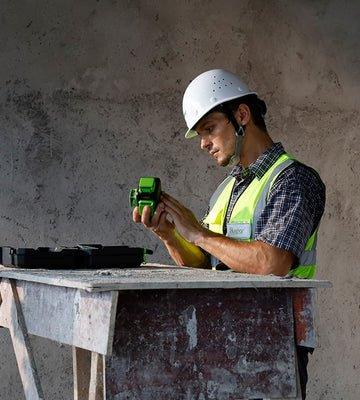Understanding 3D Laser Levels
What are 3D Laser Levels?
3d laser levels are high-tech tools for precise alignment. They project 360-degree laser lines on surfaces in three dimensions. This allows users to layout points and check levels on walls, floors, and ceilings all at once. These devices are essential for tasks that need exact measurements. They are great for installing cabinets, tiles, and drop ceilings. With a 3D laser level, you can work faster and make fewer errors. It's a favorite tool for construction workers, carpenters, and DIY enthusiasts.

How 3D Laser Levels Work
3d laser levels emit beams in all directions. They form a 360-degree layout around the tool. This makes marking and alignment easy. Here's how they work:
- The device uses a laser diode. It creates a bright, sharp line on surfaces.
- Mirrors or prisms inside help spread the laser. The laser beams shoot in X, Y, and Z axes.
- A self-leveling mechanism kicks in. It uses gravity or electronic sensors to stay level.
- This system ensures accurate horizontal and vertical lines.
Users place the level on a surface or tripod. They then use it to project lines onto work areas. These lines guide building or installation tasks. They are key for jobs needing precision.
Benefits of Using 3D Laser Levels
3d laser levels are essential tools in construction and DIY projects. Here are some benefits:
- Accuracy: They provide precise lines for level, plumb, and square references.
- Efficiency: Projects can be completed faster as manual measurements are reduced.
- Versatility: Suitable for indoor and outdoor use, on various materials and surfaces.
- User-friendly: Easy to set up and operate, even for beginners.
- Time-saving: They save time by displaying all planes simultaneously.
- Cost-effective: While initial costs can be high, they save money in the long run by avoiding mistakes and rework.
Cross Line Laser Level Vs. 3D Laser Levels
What is a Cross Line Laser Level?
A Cross Line Laser Level is a tool that projects horizontal and vertical lines. These bright lines help guide tasks such as tiling, framing, or installing cabinets. It is best for indoor use on smaller jobs. This tool can show lines on walls, floors, and ceilings. This makes it great for precise leveling jobs inside your home or shop. Unlike complex levels, it is often simple to use, making it popular for DIY projects.
Key Differences Between Cross Line and 3D Laser Levels
Cross Line and 3d laser levels are different tools. Let's look at the main differences:
- Beam Projection: Cross Line lasers emit cross beams. 3D lasers project 360-degree lines.
- Usage: Cross Line is for basic tasks. 3D is for complex layouts.
- Accuracy: 3D levels offer higher precision for full room works.
- Price: 3D laser levels are often more costly due to technology.
Choose based on your project's need for detail and complexity.
Which Laser Level Should You Choose?
Choosing the right laser level depends on your needs. A cross line laser might do for simple tasks. But for complex projects, a 3D laser level is ideal. It offers more precision and options. It can project lines around corners and over long distances. It's perfect for detailed construction jobs. When picking, think of your project's scale and detail. Also, consider how often you'll use it. For pros, a 3D level is a solid investment. For once-in-a-while use, a cross line level might suffice.
Advancements and Considerations in Laser Levels
What are 4D Laser Levels?
4D laser levels are the next step in leveling technology. Unlike simpler models, they project lines on all four walls, including the ceiling and floor. This means you get a 360-degree layout without moving the device. These advanced tools are ideal for complex projects where precision is key. They can self-level and often connect to apps for extra control. Complex tasks become easier with a 4D laser level.
Cutting-Edge Features in Modern Laser Levels
Modern laser levels come packed with features that enhance precision and ease of use. Key advancements include:
- Bluetooth Connectivity: This allows users to control the laser level with a smartphone app.
- Green Beam Technology: Green lasers are more visible than red ones, improving accuracy in bright conditions.
- Pulse Mode: For use with a detector, pulse mode extends the working range of the laser outdoors.
- Self-Leveling: Advanced gyros and pendulum systems ensure the device is perfectly level before projecting lines.
- Long Battery Life: With efficient power use, modern levels can run longer on a single charge.
- Rugged Design: Built to withstand rough handling on job sites, with features like water and dust resistance.
These features help make laser leveling tasks quicker, more accurate, and more reliable.
Selecting the Right Laser Level for Your Project
Choosing the correct laser level is vital for project success. Here are tips to help:
- Understand Your Needs: Define what precision and features you require.
- The Project's Nature: Consider whether you need 3D capabilities or if a simple cross line will do.
- Ease of Use: Pick a model that's user-friendly, with clear instructions.
- Durability: Ensure the laser level can withstand the project's environment.
- Budget: Balance the cost with the features and durability you need.
- Brand Reputation: Research which brands offer the best post-purchase support and warranty.
Remember, the right tool can make all the difference in your work's accuracy and efficiency.




